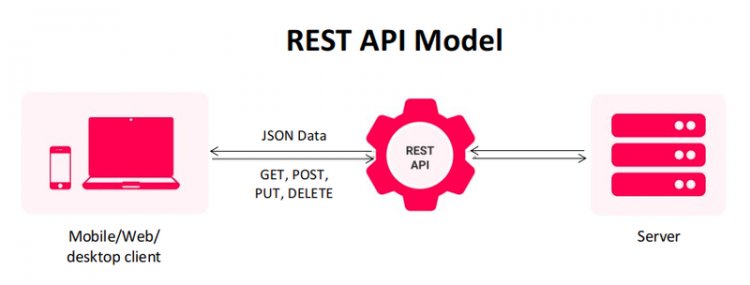RESTful Web Services - Messages

RESTful Web Services: A Comprehensive Guide
In today's digital age, the exchange of information between client and server plays a pivotal role in web applications. RESTful web services, built upon the HTTP protocol, have emerged as a cornerstone of modern web development. This article will delve into the world of RESTful web services, exploring their fundamental principles, architecture, and best practices.
Table of Contents
- Introduction to RESTful Web Services
- Understanding HTTP and Its Role
- REST vs. SOAP: Choosing the Right Protocol
- The Core Principles of REST
- Resource Identification
- Stateless Communication
- Representational State Transfer (REST)
- RESTful Endpoints and URIs
- HTTP Methods and Their Significance
- GET: Retrieving Data
- POST: Creating Resources
- PUT: Updating Resources
- DELETE: Removing Resources
- Handling Errors and Status Codes
- Content Negotiation and Response Formats
- JSON vs. XML
- Authentication and Authorization
- OAuth 2.0: A Popular Choice
- Securing RESTful APIs
- SSL/TLS for Data Encryption
- Pagination and Data Filtering
- Versioning REST APIs
- Caching for Performance Optimization
- Testing and Documentation
- Swagger and OpenAPI
- Best Practices for Designing RESTful APIs
Now, let's explore each of these topics in detail.
1. Introduction to RESTful Web Services
REST is a set of architectural principles for designing web services. It defines how resources are identified, how they are represented, and how they are manipulated. RESTful web services are designed to be lightweight, scalable, and easy to use.
The main constraints of REST are:
- Resource identification: Resources are identified by URIs (Uniform Resource Identifiers).
- Resource representation: Resources are represented in a format that is understandable by both the client and the server. JSON (JavaScript Object Notation) and XML (Extensible Markup Language) are commonly used formats for representing resources.
- Uniform interface: The same HTTP methods (GET, POST, PUT, DELETE) are used to access all resources.
- Statelessness: The server does not store any state about the client. This makes RESTful web services scalable and efficient.
- Cacheability: Resources can be cached by the client or by intermediaries, such as proxies and load balancers. This can improve performance and reduce load on the server.
RESTful web services are often used to create APIs (Application Programming Interfaces). APIs are used to allow different applications to communicate with each other. RESTful APIs are a popular choice for APIs because they are lightweight, scalable, and easy to use.
2. Understanding HTTP and Its Role
HTTP stands for Hypertext Transfer Protocol. It is a set of rules for how computers communicate over the internet. HTTP is the foundation of the World Wide Web, and it is used to transfer all types of data, including text, images, videos, and audio.
HTTP is a client-server protocol. This means that one computer, the client, makes a request to another computer, the server. The server then responds to the request.
The HTTP request is made up of three parts:
- The method: This specifies the action that the client wants to perform on the server. The most common methods are GET, POST, PUT, and DELETE.
- The URI: This specifies the resource that the client is requesting. The URI can be a URL, a file path, or any other identifier for a resource.
- The headers: This is a list of additional information that the client can send to the server. The headers can be used to specify things like the content type of the request, the authentication credentials, or the caching policy.
The HTTP response is made up of three parts:
- The status code: This specifies the success or failure of the request. The most common status codes are 200 (OK), 400 (Bad Request), and 500 (Internal Server Error).
- The reason phrase: This is a human-readable explanation of the status code.
- The body: This is the actual data that the server is sending to the client. The body can be text, images, videos, or any other type of data.
HTTP is a simple but powerful protocol that allows computers to communicate over the internet. It is the foundation of the World Wide Web, and it is used by billions of people every day.
3. REST vs. SOAP: Choosing the Right Protocol
REST (Representational State Transfer) and SOAP (Simple Object Access Protocol) are two different architectural styles for creating web services. They have different strengths and weaknesses, and the best choice for a particular application will depend on the specific requirements.
REST is a lightweight architectural style that uses HTTP verbs to define the operations that can be performed on resources. It is easy to understand and implement, and it is well-suited for simple applications. RESTful web services are often used to expose data to clients, such as in e-commerce applications or in APIs.
SOAP is a more complex architectural style that uses XML to define the messages that are exchanged between clients and servers. It is more verbose than REST, but it provides more flexibility and features, such as support for complex data types and transactions. SOAP web services are often used in enterprise applications where reliability and security are important.
Here is a table that summarizes the key differences between REST and SOAP:
| Feature | REST | SOAP |
|---|---|---|
| Architectural style | Lightweight, stateless | Heavyweight, stateful |
| Message format | JSON, XML | XML |
| Transport protocol | HTTP | HTTP, SMTP, JMS |
| Security | Encryption can be implemented at the application layer | Security is built-in |
| Flexibility | More flexible | Less flexible |
| Ease of implementation | Easier to implement | More difficult to implement |
| Suitability for simple applications | Yes | No |
| Suitability for complex applications | No | Yes |
| Suitability for enterprise applications | No | Yes |
REST (Representational State Transfer) and SOAP (Simple Object Access Protocol) are two different architectural styles for creating web services. They have different strengths and weaknesses, and the best choice for a particular application will depend on the specific requirements.
REST is a lightweight architectural style that uses HTTP verbs to define the operations that can be performed on resources. It is easy to understand and implement, and it is well-suited for simple applications. RESTful web services are often used to expose data to clients, such as in e-commerce applications or in APIs.
SOAP is a more complex architectural style that uses XML to define the messages that are exchanged between clients and servers. It is more verbose than REST, but it provides more flexibility and features, such as support for complex data types and transactions. SOAP web services are often used in enterprise applications where reliability and security are important.
Here is a table that summarizes the key differences between REST and SOAP:
| Feature | REST | SOAP |
|---|---|---|
| Architectural style | Lightweight, stateless | Heavyweight, stateful |
| Message format | JSON, XML | XML |
| Transport protocol | HTTP | HTTP, SMTP, JMS |
| Security | Encryption can be implemented at the application layer | Security is built-in |
| Flexibility | More flexible | Less flexible |
| Ease of implementation | Easier to implement | More difficult to implement |
| Suitability for simple applications | Yes | No |
| Suitability for complex applications | No | Yes |
| Suitability for enterprise applications | No | Yes |
- Bandwidth: REST is more bandwidth-efficient than SOAP, as it uses less data to transmit messages.
- Performance: REST is typically faster than SOAP, as it does not require the parsing of XML messages.
- Scalability: REST is more scalable than SOAP, as it does not require the maintenance of state.
- Security: REST can be secured using HTTPS, but SOAP has built-in security features.
Ultimately, the best way to choose between REST and SOAP is to consider the specific requirements of the application. If simplicity and performance are important, then REST is a good choice. If reliability and security are important, then SOAP is a better choice.
4. The Core Principles of REST
Dive deeper into the key principles of REST, including resource identification, stateless communication, and the concept of representational state transfer.
4.1 Resource Identification
4.2 Stateless Communication
4.3 Representational State Transfer (REST)
5. RESTful Endpoints and URIs
Explore the significance of URIs (Uniform Resource Identifiers) in RESTful APIs and how to design meaningful endpoints.
6. HTTP Methods and Their Significance
Learn about the essential HTTP methods and their roles in manipulating resources.
6.1 GET: Retrieving Data
6.2 POST: Creating Resources
6.3 PUT: Updating Resources
6.4 DELETE: Removing Resources
7. Handling Errors and Status Codes
Errors and status codes are an important part of REST APIs. They allow clients to understand the success or failure of a request, and they can also provide more detailed information about the error.
The most common way to handle errors in REST APIs is to use HTTP status codes. HTTP status codes are a three-digit code that indicates the success or failure of a request. The first digit of the status code indicates the general category of the error, while the remaining two digits provide more specific information.
Here are some of the most common HTTP status codes:
- 200 OK: The request was successful.
- 400 Bad Request: The request was malformed or invalid.
- 401 Unauthorized: The client is not authorized to access the resource.
- 403 Forbidden: The client is authorized to access the resource, but is not allowed to perform the requested operation.
- 404 Not Found: The requested resource does not exist.
- 500 Internal Server Error: An error occurred on the server.
- 503 Service Unavailable: The server is temporarily unavailable.
In addition to HTTP status codes, REST APIs can also use custom error codes. Custom error codes are typically used to provide more detailed information about the error. For example, a REST API might use a custom error code to indicate that a resource was not found because it was deleted.
When handling errors in REST APIs, it is important to provide the client with as much information as possible about the error. This will help the client to understand the error and to take appropriate action.
8. Content Negotiation and Response Formats
Content negotiation is the process of determining the best format for a resource's representation, based on the capabilities of the client and the server. It is used in REST APIs to allow clients to choose the format of the response that they prefer.
The most common way to implement content negotiation is to use the HTTP Accept header. The Accept header specifies the supported media types of the client. The server then selects the representation that is most compatible with the client's capabilities.
For example, a client might send an Accept header with the value application/json, text/html. This means that the client prefers JSON, but it will also accept HTML. The server would then choose the JSON representation if it is available, or the HTML representation if the JSON representation is not available.
Content negotiation can also be used to support multiple languages. For example, a server might have a resource that is available in English and French. The server would then select the representation that is in the client's preferred language.
Here are some best practices for implementing content negotiation in REST APIs:
- Use the HTTP Accept header to specify the supported media types of the client.
- Allow the server to select the representation that is most compatible with the client's capabilities.
- Support multiple languages.
- Document the supported media types and languages in the API documentation.
By following these best practices, you can ensure that your REST APIs support content negotiation in a consistent and informative way.
Here are some of the most common response formats for REST APIs:
- JSON: JavaScript Object Notation is a lightweight data-interchange format. It is human-readable and easy to parse.
- XML: Extensible Markup Language is a more complex data-interchange format. It is more verbose than JSON, but it provides more flexibility.
- CSV: Comma-separated values is a simple text format. It is easy to read and write, but it is not as flexible as JSON or XML.
- Image: Images can be represented in a variety of formats, such as PNG, JPEG, and GIF.
- Audio: Audio can be represented in a variety of formats, such as MP3, WAV, and AAC.
- Video: Video can be represented in a variety of formats, such as MP4, AVI, and MPEG.
The best response format for a REST API will depend on the specific needs of the application. For example, if the API is used to transfer data between applications, then JSON or XML might be a good choice. If the API is used to transfer images or videos, then a more specialized format might be a better choice.
8.1 JSON vs. XML
9. Authentication and Authorization
Understand the importance of authentication and authorization in securing your RESTful APIs.
9.1 OAuth 2.0: A Popular Choice
10. Securing RESTful APIs
Learn about security measures, including SSL/TLS encryption, to protect sensitive data.
11. Pagination and Data Filtering
Explore techniques for efficiently handling large datasets through pagination and filtering.
12. Versioning REST APIs
Find out how to manage API versioning to maintain backward compatibility while introducing new features.
13. Caching for Performance Optimization
Learn how caching can significantly enhance the performance of your RESTful APIs.
14. Testing and Documentation
Discover tools like Swagger and OpenAPI for testing and documenting your RESTful APIs.
15. Best Practices for Designing RESTful APIs
Explore a set of best practices to follow when designing your RESTful APIs for scalability and maintainability.
Now, let's continue our journey into the world of RESTful web services.
RESTful Web Services: Bridging the Gap
In the digital era, RESTful web services bridge the gap between clients and servers, enabling seamless communication and data exchange. These services leverage the HTTP protocol, which serves as a robust foundation for transmitting information across the World Wide Web.
Resource Identification
One of the fundamental principles of REST is the concept of resource identification. In this context, resources refer to data objects or entities that clients interact with. Each resource is uniquely identified by a URI (Uniform Resource Identifier), which acts as a universal address for accessing that resource.
Stateless Communication
RESTful web services operate in a stateless manner, meaning that each request from a client to a server must contain all the information necessary to understand and process the request. This design choice simplifies server-side logic and makes it easier to scale applications as there is no reliance on session state.
Representational State Transfer (REST)
REST, an architectural style introduced by Roy Fielding in his doctoral dissertation, emphasizes the concept of representational state transfer. In essence, it means that the state of a resource is represented in a specific format (typically JSON or XML) and can be transferred between client and server. This state transfer is at the heart of RESTful communication.
In the next sections, we will delve deeper into various aspects of RESTful web services, including HTTP methods, error handling, security, and best practices for designing APIs.
GET: Retrieving Data
The GET method is one of the most commonly used HTTP methods in RESTful APIs. It is employed to retrieve data from a specified resource. When a client sends a GET request to a server, it essentially asks for the representation of the resource identified by the URI.
POST: Creating Resources
The POST method is used when a client wants to create a new resource on the server. It submits data to be processed to a specified resource. In many cases, this involves adding a new record to a database or creating a new entity.
PUT: Updating Resources
The PUT method is employed to update an existing resource or create one if it doesn't exist. It replaces the current representation of the resource with the new one provided in the request. This method is idempotent, meaning that multiple identical requests will produce the same result as a single request.
DELETE: Removing Resources
The DELETE method is straightforward—it is used to request the removal of a resource identified by the URI. Upon successful deletion, the server should respond with an appropriate status code, typically 204 (No Content).
In the upcoming sections, we will explore how to handle errors and status codes, negotiate content formats, implement authentication and authorization, secure RESTful APIs, and optimize performance through caching.
Handling Errors and Status Codes
In the world of RESTful web services, communication isn't always flawless. Errors can occur, and it's essential to handle them gracefully. HTTP status codes play a crucial role in conveying the outcome of a request.
Content Negotiation and Response Formats
When dealing with RESTful APIs, the choice of response format is pivotal. Two popular options are JSON (JavaScript Object Notation) and XML (eXtensible Markup Language). Each has its strengths and weaknesses, and the choice depends on the specific requirements of your application.
JSON vs. XML: Which One to Choose
The decision between JSON and XML often boils down to factors like data structure complexity, readability, and the needs of the consuming client. JSON is lightweight, human-readable, and widely supported in modern web development, making it a popular choice for many RESTful APIs.
In the following sections, we will explore topics such as authentication and authorization, securing RESTful APIs, pagination, versioning, caching, and testing and documentation.
Authentication and Authorization
The security of your RESTful APIs is of paramount importance, especially when handling sensitive data or providing access to valuable resources. Authentication and authorization mechanisms ensure that only authorized users can access certain endpoints and perform specific actions.
OAuth 2.0: A Popular Choice
OAuth 2.0 is a widely adopted framework for handling authentication and authorization. It enables third-party applications to access resources on behalf of a user, without revealing the user's credentials. Popular services like Google and Facebook use OAuth 2.0 for secure authentication.
Securing RESTful APIs
Securing your RESTful APIs is essential to protect sensitive data and prevent unauthorized access. One of the fundamental security measures is the use of SSL/TLS encryption to secure data transmission over the network.
In the subsequent sections, we will explore additional topics such as pagination, versioning, caching, testing, and documentation, all of which are crucial aspects of building robust RESTful web services.
Pagination and Data Filtering
Efficiently handling large datasets is a common challenge in web development. Pagination and data filtering techniques allow clients to retrieve only the data they need, improving response times and reducing server load.
Versioning REST APIs
As your API evolves and grows, it's crucial to maintain backward compatibility with existing clients while introducing new features. Proper versioning of RESTful APIs ensures that changes do not disrupt existing integrations.
Caching for Performance Optimization
Caching is a powerful tool for optimizing the performance of RESTful APIs. By storing frequently accessed responses, you can reduce the load on your server and improve response times for clients.
Testing and Documentation
Comprehensive testing and documentation are essential for successful API development. Tools like Swagger and OpenAPI make it easier to describe, test, and document your RESTful APIs.
In conclusion, RESTful web services have revolutionized the way applications communicate over the internet. By adhering to REST principles and best practices, developers can create scalable, secure, and efficient APIs that meet the needs of modern web applications.
Conclusion
In this comprehensive guide, we have explored the world of RESTful web services, from their fundamental principles to advanced topics such as security, versioning, and performance optimization. By understanding these concepts and following best practices, you can design and implement RESTful APIs that stand the test of time.
Frequently Asked Questions
-
What is the difference between REST and SOAP?
REST and SOAP are two different approaches to web services. REST is lightweight, stateless, and relies on standard HTTP methods, while SOAP is a protocol with a rigid structure and additional features like security and transactions.
-
How do I secure my RESTful API?
Securing a RESTful API involves using authentication, authorization, and encryption. OAuth 2.0 is a popular choice for authentication, and SSL/TLS encryption ensures data privacy.
-
What is content negotiation in RESTful APIs?
Content negotiation is the process of determining the most suitable response format (e.g., JSON or XML) based on the client's preferences and the server's capabilities.
-
What are the advantages of versioning REST APIs?
API versioning allows you to introduce changes without breaking existing client applications. It ensures backward compatibility and smooth transitions for users.
-
Why is caching important in RESTful APIs?
Caching improves API performance by storing and reusing frequently accessed responses, reducing the load on the server and enhancing the user experience.

 Donald Green
Donald Green 













